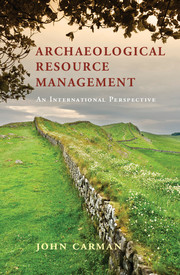1 - Historical antecedents to archaeological resource management
from Part I - History and Principles
Published online by Cambridge University Press: 05 September 2015
Summary
A definitive – or indeed reasonably complete – history of archaeological resource management (ARM) that goes beyond the specifics of individual territories has yet to be written. So far as broader histories of archaeology are concerned (e.g., Daniel 1978; Daniel and Renfrew 1988; Trigger 1989; 2006; Schnapp 1996), the management and preservation of remains generally form a minor element in a broadly evolutionary intellectual history. ARM appears more prominently in national stories of archaeological endeavour as well as forming the content of more focused research. Useful – albeit brief – overviews often preface discussions of national ARM practice (see, e.g., papers in Cleere 1984a; papers in Pickard 2001b; Pugh-Smith and Samuels 1996, 3–7) and occasionally form complete contributions in others (e.g., Boulting 1976; papers in Hunter 1996; Fowler 1986; Knudson 1986). Where specific papers are written on aspects of the history of ARM, they either tend to focus on particular moments (e.g., Chippindale 1983; Saunders 1983; Twohig 1987; Chapman 1989; Murray 1990; Evans 1994; Firth 1999) or are designed to support a particular view of archaeology (e.g., Carman 1993; Kristiansen 1996).
This chapter and the two that follow do not claim to offer the definitive global history that the field perhaps requires and deserves, but they do hopefully represent the first outlines of what such a history might look like. The history of ARM is interesting: more interesting, perhaps, than previous attempts at partial history have often made it appear. The aim of this chapter is therefore to provide not only a narrative of key moments within the emergence of the ARM idea but also a rough outline of a Foucauldian ‘archaeology’ (as in Foucault 1970; 1972; 1977) or a Nietzschean genealogy (as in Nietzsche 1899) of the notions that came together to create the global system of ARM that we see today. This is approached from the perspective that ARM as we know it was not necessarily the intention of those who first created mechanisms to preserve objects from the past; indeed, it proceeds from the idea that this is exactly what they did not intend at all.
In contrast to much of the rest of the book – which will focus inevitably on what is common across territorial boundaries in the practice of ARM – this chapter will celebrate the diverse origins of what is now ARM in different countries, under different regimes and at different times. Although organised roughly chronologically – with the earliest instances of ARM-like practices first – it is, more importantly, organised thematically, to show the different ideologies and contexts within which the idea grew, and some of the historical processes that have contributed to its rise. The culminating section of this chapter is not the emergence of a universal ARM, because the emergence of a large measure of global agreement on how we should preserve our material pasts is more properly the topic of the next chapter, which brings us to our own time, but instead consists of one distinctive contribution to the rise of the idea that we should do so. This in turn has become one of the most influential national ‘strands’ of ARM – one that has contributed much to the field – but it is doubtful that this was intended at the time. This inherent ‘nationalism’ of the field is itself an important element in ARM as it has developed, and derives directly from its diverse historical origins, but it is still a potent force in the way ARM is practised, despite the global acceptance of common practices and principles.
- Type
- Chapter
- Information
- Archaeological Resource ManagementAn International Perspective, pp. 3 - 27Publisher: Cambridge University PressPrint publication year: 2015

